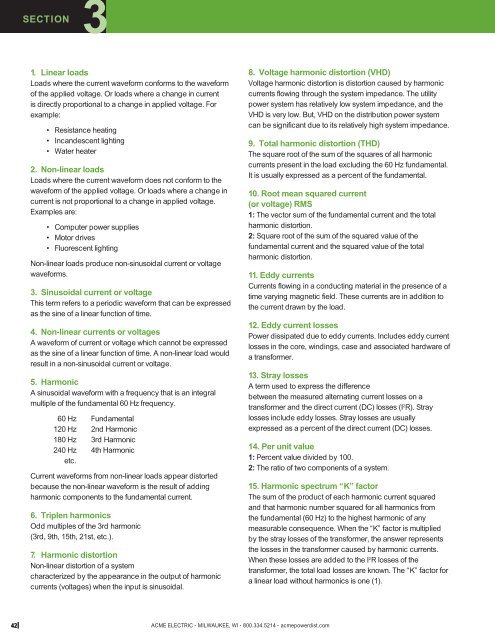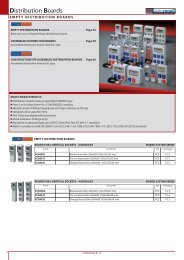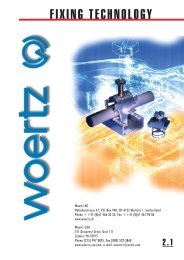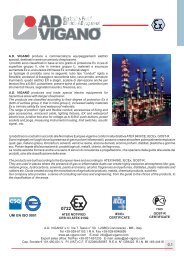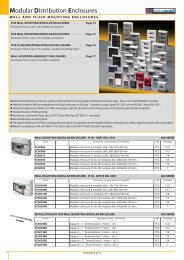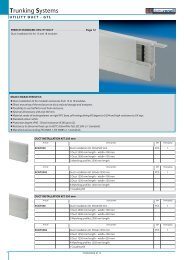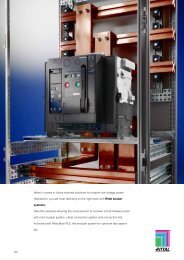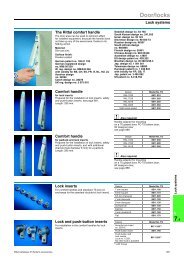Acme Product Catalog - Ranger Enterprise Company Limited
Acme Product Catalog - Ranger Enterprise Company Limited
Acme Product Catalog - Ranger Enterprise Company Limited
You also want an ePaper? Increase the reach of your titles
YUMPU automatically turns print PDFs into web optimized ePapers that Google loves.
42<br />
SECTION NON-LINEAR LOAD ISOLATION ® 3<br />
SECTION TRANSFORMERS<br />
1. Linear loads<br />
Loads where the current waveform conforms to the waveform<br />
of the applied voltage. Or loads where a change in current<br />
is directly proportional to a change in applied voltage. For<br />
example:<br />
Resistance heating<br />
Incandescent lighting<br />
Water heater<br />
2. Non-linear loads<br />
Loads where the current waveform does not conform to the<br />
waveform of the applied voltage. Or loads where a change in<br />
current is not proportional to a change in applied voltage.<br />
Examples are:<br />
Computer power supplies<br />
Motor drives<br />
Fluorescent lighting<br />
Non-linear loads produce non-sinusoidal current or voltage<br />
waveforms.<br />
3. Sinusoidal current or voltage<br />
This term refers to a periodic waveform that can be expressed<br />
as the sine of a linear function of time.<br />
4. Non-linear currents or voltages<br />
A waveform of current or voltage which cannot be expressed<br />
as the sine of a linear function of time. A non-linear load would<br />
result in a non-sinusoidal current or voltage.<br />
5. Harmonic<br />
A sinusoidal waveform with a frequency that is an integral<br />
multiple of the fundamental 60 Hz frequency.<br />
60 Hz Fundamental<br />
120 Hz 2nd Harmonic<br />
180 Hz 3rd Harmonic<br />
240 Hz 4th Harmonic<br />
etc.<br />
Current waveforms from non-linear loads appear distorted<br />
because the non-linear waveform is the result of adding<br />
harmonic components to the fundamental current.<br />
6. Triplen harmonics<br />
Odd multiples of the 3rd harmonic<br />
(3rd, 9th, 15th, 21st, etc.).<br />
7. Harmonic distortion<br />
Non-linear distortion of a system<br />
characterized by the appearance in the output of harmonic<br />
currents (voltages) when the input is sinusoidal.<br />
ACME ELECTRIC MILWAUKEE, WI 800.334.5214 acmepowerdist.com<br />
8. Voltage harmonic distortion (VHD)<br />
Voltage harmonic distortion is distortion caused by harmonic<br />
currents flowing through the system impedance. The utility<br />
power system has relatively low system impedance, and the<br />
VHD is very low. But, VHD on the distribution power system<br />
can be significant due to its relatively high system impedance.<br />
9. Total harmonic distortion (THD)<br />
The square root of the sum of the squares of all harmonic<br />
currents present in the load excluding the 60 Hz fundamental.<br />
It is usually expressed as a percent of the fundamental.<br />
10. Root mean squared current<br />
(or voltage) RMS<br />
1: The vector sum of the fundamental current and the total<br />
harmonic distortion.<br />
2: Square root of the sum of the squared value of the<br />
fundamental current and the squared value of the total<br />
harmonic distortion.<br />
11. Eddy currents<br />
Currents flowing in a conducting material in the presence of a<br />
time varying magnetic field. These currents are in addition to<br />
the current drawn by the load.<br />
12. Eddy current losses<br />
Power dissipated due to eddy currents. Includes eddy current<br />
losses in the core, windings, case and associated hardware of<br />
a transformer.<br />
13. Stray losses<br />
A term used to express the difference<br />
between the measured alternating current losses on a<br />
transformer and the direct current (DC) losses (I 2 R). Stray<br />
losses include eddy losses. Stray losses are usually<br />
expressed as a percent of the direct current (DC) losses.<br />
14. Per unit value<br />
1: Percent value divided by 100.<br />
2: The ratio of two components of a system.<br />
15. Harmonic spectrum “K” factor<br />
The sum of the product of each harmonic current squared<br />
and that harmonic number squared for all harmonics from<br />
the fundamental (60 Hz) to the highest harmonic of any<br />
measurable consequence. When the “K” factor is multiplied<br />
by the stray losses of the transformer, the answer represents<br />
the losses in the transformer caused by harmonic currents.<br />
When these losses are added to the I 2 R losses of the<br />
transformer, the total load losses are known. The “K” factor for<br />
a linear load without harmonics is one (1).


